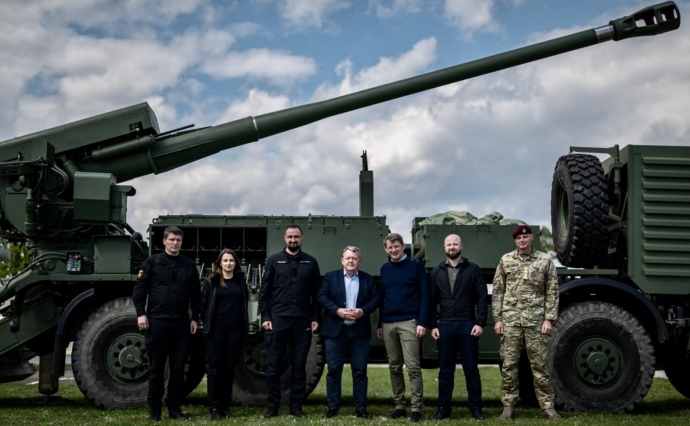Ukraine is rapidly expanding its defense industry amid the ongoing war with Russia. It is revitalizing old factories and establishing new ones, some with foreign investment. The primary challenge, however, is funding rather than production capacity.
In late 2023, a funding shortage became apparent as arms companies, resilient under missile attacks and with secured government contracts, found themselves able to produce far more than the state could afford. For 2024, factories can manufacture $20 billion worth of weapons, yet the state can only contract $6 billion - just a third of the industry's capacity.
To address this, Ukraine launched the ZBROYARI (Weapons makers) initiative, involving key ministries, embassies, and the President's Office. The goal is to raise $10 billion for domestic manufacturers by securing contracts using Western military aid funds.
This approach could increase weapon production with cost-effective Ukrainian models while supporting the local economy. Progress is evident, with various countries agreeing to allocate $675 million for Ukrainian factory contracts in recent months.
"Our main task is to find additional funding for the defense forces in Ukraine. My goal is to secure financing for production in Ukraine since we have additional unused capacity," Oleksandr Kamyshin, Ukraine's Minister of Strategic Industries, emphasized in May.
He highlighted that Ukraine's economy is ten times smaller than Russia's, resulting in significantly less funding for military equipment procurement and production.
Euromaidan Press investigates Ukraine's defense industry diplomacy, revealing current contracts, ongoing negotiations, and the rationale behind the controversial ban on arms exports from Ukrainian factories. Originally published in Ukrainian by Ekonomichna Pravda, this English version brings these developments to a wider audience.
The art of Ukraine's defense diplomacy
The ZBROYARI initiative, spearheaded by key Ukrainian officials, aims to showcase Ukraine's capacity for producing high-quality weapons on a larger scale. At international meetings, Ukrainian representatives consistently highlight this potential to their partners.
To bolster their case, Ukraine has implemented a multi-faceted approach:
- Western partners are invited to witness tests of Ukrainian military equipment and tour manufacturing facilities, providing tangible evidence of Ukraine's capabilities.
- Ukrainian defense agencies actively seek influential advocates in the West and maintain a presence at major international events.
- Recognizing the unique priorities of each ally, Ukraine develops customized strategies for negotiations.
This endeavor faces significant challenges. Western countries naturally prioritize their own defense industries, aiming to develop domestic technologies and stimulate their economies. Additionally, Ukraine is still establishing its reputation as a weapons manufacturer, with many domestic companies only recently beginning to engage with Western states.
To overcome these hurdles, Ukraine must present compelling arguments to secure funding for local weapons production.
Ukraine squeezes every last drop for defense in 2024 budget, Russia still 2.5x more
Denmark's historic investment in Ukraine's defense
Denmark has become the first country to join Ukraine's ZBROYARI initiative. The idea was initially discussed during a winter meeting between Ukrainian President Volodymyr Zelenskyy and Danish Prime Minister Mette Frederiksen, with subsequent negotiations coordinated by Ambassador Andrii Yanevskyi.
Two months after these talks, Denmark allocated a groundbreaking military aid package that included $170 million specifically for Ukrainian weapons manufacturers. This marks the first time in history that a foreign country has directly funded Ukraine's arms industry. A significant portion of this funding will finance the purchase of 18 Bohdana self-propelled artillery units.
President Zelenskyy highlighted Ukraine's current position as Europe's leading producer of self-propelled artillery units on a monthly basis, underscoring the country's growing capabilities in defense manufacturing.

Canada's drone deal pivot
Canada has become the second country to participate in Ukraine's initiative to boost its domestic defense industry. The Ministry of Strategic Industries revealed that Canadian involvement began during Canadian Defense Minister Bill Blair's visit to Ukraine.
Initially, Canada allocated $95 million for 800 Canadian SkyRanger R70 drones as part of the Drone Coalition, an allied initiative to supply unmanned systems to the Ukrainian Armed Forces. Seizing this opportunity, Ukraine immediately began advocating for its own manufacturers, showcasing drones as a strength of its defense-industrial complex.
In a strategic move, Ukrainian officials presented Blair with a comparative analysis of the SkyRanger R70 and its Ukrainian counterparts, highlighting that the domestic options were several times less expensive.
"We thanked Bill Blair for the drones, but presented a comparison between SkyRanger R70 and cheaper Ukrainian alternatives. We proposed purchasing a test batch of Ukrainian drones," says the Ukrainian Ministry of Strategic Industries source.
This led to Canada agreeing to allocate an additional $2.1 million specifically for Ukrainian-made drones.
Trending Now
Midnight diplomacy secures Dutch funds for Ukrainian drones
A notable moment in Netherlands-Ukraine defense cooperation occurred during an unconventional meeting. As Dutch Defense Minister Kajsa Ollongren headed to Kyiv, Ukrainian officials were Berlin-bound. Eager for face-to-face discussions, they arranged a 1 AM meeting at Lviv railway station — their only possible intersection point.
Following this, the Ukrainian Ministry of Defense hosted Dutch representatives at Ukrainian military factories. The visit bore fruit:
- The Dutch government agreed to finance €17.5 million for Ukrainian NAVY drones.
- An additional €20 million was allocated for FPV drones.

Ukraine's ongoing global defense dialogues
The European Union is set to become the largest donor to the initiative, pledging €400 million. According to Oleksandr Kamyshin, Ukraine's Minister of Strategic Industries, this funding is expected to come from the €1.4 billion in profits from frozen Russian assets. However, the specifics of the allocation mechanism and timeline remain unclear.
The key challenge is engaging Germany and the UK, countries with influential defense firms they prioritize. However, Ukraine has likely found diplomatic leverage to convince them.
Ukroboronprom, Ukraine's state defense concern, recently formed a joint venture with German Rheinmetall to produce Lynx infantry fighting vehicles in Ukraine.
“The Germans will finance the contract for their own company, but the final assembly will occur at Ukraine factories,” Kamyshin explains.
A similar approach has shown promise with the British government, with discussions underway to finance L119 howitzer repairs at Ukrainian facilities, supported by developer BAE Systems.
US funding is also being pursued. Ukroboronprom plans to establish a joint equipment repair and maintenance plant with American Amentum Services, and additional enterprises are planned, including collaborations with major firms like Northrop Grumman.
Ukraine's struggle with defense export strategies
Another potential solution for Ukraine's idle defense production facilities — foreign contracts and arms exports — was briefly considered in late 2023 by the Ministries of Strategic Industries and Defense. However, the idea was shelved due to a lack of support from top government officials.
The main concern is reputational risk. Ukraine seeking weapons from Western allies while simultaneously selling its own could be exploited by Russian propagandists, potentially jeopardizing international support. Additionally, restricting exports maintains the state's monopoly on domestic arms procurement, ensuring manufacturer dependence on government contracts.
This challenge isn't unique. Israel once faced a similar situation, resolving it by negotiating with the US to convert 25% of their military aid into shekels for purchasing from Israeli factories. This strategy bolstered Israel's defense industry, leading to technological advancements and establishing the country as a major arms exporter.
Ukraine aims to adapt this model to its circumstances. However, lacking a wealthy, long-term ally willing to invest heavily in a foreign defense industry, Ukraine has opted for a more diversified approach. The government is working individually with various allies, crafting bespoke strategies for each partnership.
******
Ukraine's defense diplomacy is yielding tangible results. The country has secured $675 million from foreign partners for its domestic defense industry, marking significant progress towards its $10 billion goal. This represents about 10% of the annual state order for Ukrainian manufacturers, demonstrating the ZBROYARI initiative's initial success.
While these agreements are not final, they showcase Ukraine's ability to leverage Western aid creatively. By highlighting its manufacturing capabilities and tailoring approaches to different allies, Ukraine is gradually transforming its defense sector amidst ongoing challenges.
Related:
- Canada becomes the second country to commit to funding Ukrainian weapons production
- Ukraine lacks USD 10 billion to contract all domestic weapons production capabilities — Minister
- Denmark breaks new ground, funding domestic Ukrainian arms production





